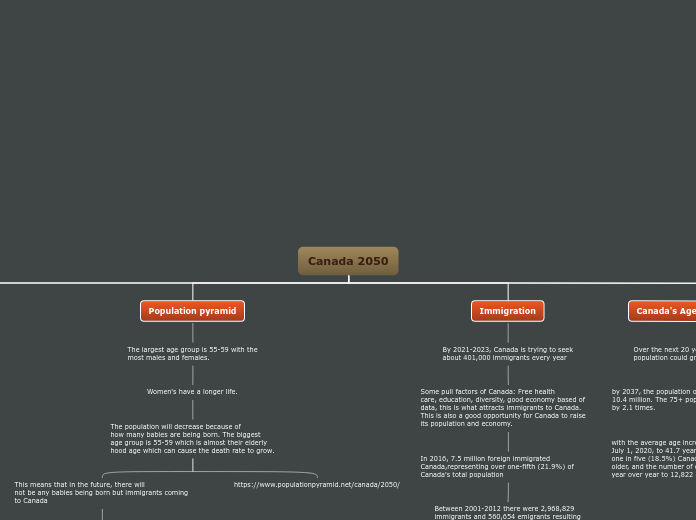Canada 2050
population
by 2050, Canada could have about 48.8
million people living
It could also drop, if the deaths rise.
The only way Canada can raise its population would be to have more babies being born or seeking more immigrants to Canada which can makes its population by 39.82 in 2050-2060
Canada's Ageing Population
Over the next 20 years, Canada's senior
population could grow by 68%
by 2037, the population of seniors could become 10.4 million. The 75+ population can double Canada by 2.1 times.
with the average age increasing from 41.4 years on July 1, 2020, to 41.7 years on July 1, 2021. Almost one in five (18.5%) Canadians are now aged 65 and older, and the number of centenarians rose 1,100 year over year to 12,822 as of July 1, 2021.
Immigration
By 2021-2023, Canada is trying to seek
about 401,000 immigrants every year
Some pull factors of Canada: Free health
care, education, diversity, good economy based of data, this is what attracts immigrants to Canada.
This is also a good opportunity for Canada to raise its population and economy.
In 2016, 7.5 million foreign immigrated
Canada,representing over one-fifth (21.9%) of Canada's total population
Between 2001-2012 there were 2,968,829
immigrants and 560,654 emigrants resulting
a net migration of 2,408,175 people.
By 2011 Canada had a total of about 6,775,800 foreign-born individuals who arrived as immigrants. They represented 20.6% of the total population, compared with 19.8% in the 2006 census, and 17.6% in 2001
Recently the amount of immigrants Ontario received was 43.1% and British Columbia received 15.9%. In 2006, Ontario had received 52.3% of the newcomers and British Columbia, 16.0%. The decline of the amount of newcomers in these two provinces was due to a shifting of shares to the other provinces.
Among all recent immigrants who arrived between 2006 and 2011, roughly 661,600 or 56.9% came from Asia (including the Middle East). This calculation decreased slightly as compared to when 60.0% of people from Asia arrived between 2001 and 2005.
In 2006 the employment rate for recent immigrants was 58.9%. This percentage increased much quicker than what was expected for immigrants looking for employment around 10 years ago.
Population pyramid
The largest age group is 55-59 with the
most males and females.
Women's have a longer life.
The population will decrease because of
how many babies are being born. The biggest
age group is 55-59 which is almost their elderly
hood age which can cause the death rate to grow.
https://www.populationpyramid.net/canada/2050/
This means that in the future, there will
not be any babies being born but immigrants coming to Canada
In 2020, there were more males then
females, but as the ages grown on, there were more women's then men.
age group
was 55-59
Changing faces of Canada
Trends
South Asian population will be a larger demographic group in Ontario in the year 2050
From 2011, in Brampton the biggest diverse group was south Asians, but with all the diverse group all together in Ontario, the south Asian population is more.
by 2050, the South Asian population will take
half or more of Canada's diverse population all together
By 2050, the aboriginal population will be about 7% of Canada's population
Main topic
Subtopic









